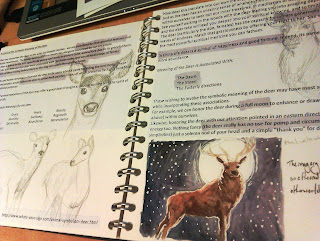Beginning the Research

Extract from the 'Dictionary of Symbols' and watercolour studies
I chose to study the insect family by the name of Scarabaeidae, or most commonly known as the Scarab family. This is a family of beetles that makes up around 10% of all insects and therefore is incredibly wide spread. Some of the most common beetles under the Scarabaeidae term are Dungbeetles, Cockchafers and even the so called 'Thunder bugs' which are drawn to incredibly bright colours during summer. I was fascinated by this super family and began my research by finding a dictionary definition of 'Scarab' and exploring a few different ways to portray the most widely known type of scarab. Within my research, one thing that would crop up every few passages was their connection to the ancient Egyptians, whom believed that the Scarabs had eternal life, reincarnated through the balls of dung they would roll. They were often depicted in images laced with gold and therefore I chose to do the same thing, use golden paint to highlight certain areas of their bodies.

Acrylic paintings with Liquid Leaf golden highlights

Extract from the 'Dictionary of Symbols' and watercolour studies
I chose to study the insect family by the name of Scarabaeidae, or most commonly known as the Scarab family. This is a family of beetles that makes up around 10% of all insects and therefore is incredibly wide spread. Some of the most common beetles under the Scarabaeidae term are Dungbeetles, Cockchafers and even the so called 'Thunder bugs' which are drawn to incredibly bright colours during summer. I was fascinated by this super family and began my research by finding a dictionary definition of 'Scarab' and exploring a few different ways to portray the most widely known type of scarab. Within my research, one thing that would crop up every few passages was their connection to the ancient Egyptians, whom believed that the Scarabs had eternal life, reincarnated through the balls of dung they would roll. They were often depicted in images laced with gold and therefore I chose to do the same thing, use golden paint to highlight certain areas of their bodies.

Acrylic paintings with Liquid Leaf golden highlights
Celestial Navigation

Watercolour and salt painting. Liquid leaf golden highlights
After completing some further research by contacting Entomologist, Moya Burns, I discovered that this super family had the ability to Navigate using the stars, which is something that utterly fascinated me. I researched how we, as humans could achieve the same thing. Scarabs navigate differently to us, they are able to do so using the milky way but, we as humans rarely have strong enough eyes to do this without technical support.
Developing the Final Piece
During a tutorial I realised that the thing I wanted to depict about these creatures was my fascination with their navigation skills, this brought me to the Victorian circus posters which often promised the experience to see something never seen before, something spectacular, when in reality the shows weren't as exciting as promised. I felt the same about these Scarabs, they had an amazing ability but, if faced with one, it would be far smaller than expected and probably wouldn't move whilst you were there. I wanted to use this to my advantage and set out to produce an A2 poster that promised grandeur.
The Final Piece

Final A2 poster.
The final piece was completed in 4 different stages, the painting of the actual base, the adding in of the celestial chart through photoshop, the printing onto an A2 sheet and then the addition of the golden paint. Almost entirely central in this piece is the star Polaris which is the brightest and most northern point in our skies within the northern hemisphere. The gold bands around the scarabs shell represent the equator which separates the northern and southern hemisphere so that there is no confusion about whether the two constellations (which represent how we, as humans can navigate using the night sky) are connected to one another.

Watercolour and salt painting. Liquid leaf golden highlights
After completing some further research by contacting Entomologist, Moya Burns, I discovered that this super family had the ability to Navigate using the stars, which is something that utterly fascinated me. I researched how we, as humans could achieve the same thing. Scarabs navigate differently to us, they are able to do so using the milky way but, we as humans rarely have strong enough eyes to do this without technical support.
Developing the Final Piece
During a tutorial I realised that the thing I wanted to depict about these creatures was my fascination with their navigation skills, this brought me to the Victorian circus posters which often promised the experience to see something never seen before, something spectacular, when in reality the shows weren't as exciting as promised. I felt the same about these Scarabs, they had an amazing ability but, if faced with one, it would be far smaller than expected and probably wouldn't move whilst you were there. I wanted to use this to my advantage and set out to produce an A2 poster that promised grandeur.
The Final Piece

Final A2 poster.
The final piece was completed in 4 different stages, the painting of the actual base, the adding in of the celestial chart through photoshop, the printing onto an A2 sheet and then the addition of the golden paint. Almost entirely central in this piece is the star Polaris which is the brightest and most northern point in our skies within the northern hemisphere. The gold bands around the scarabs shell represent the equator which separates the northern and southern hemisphere so that there is no confusion about whether the two constellations (which represent how we, as humans can navigate using the night sky) are connected to one another.



